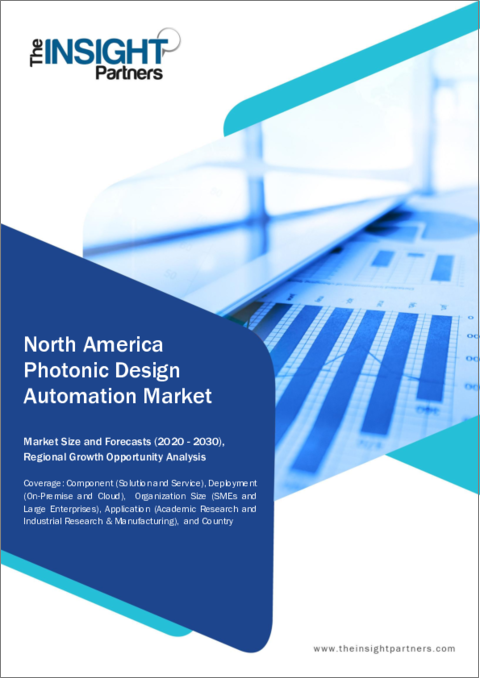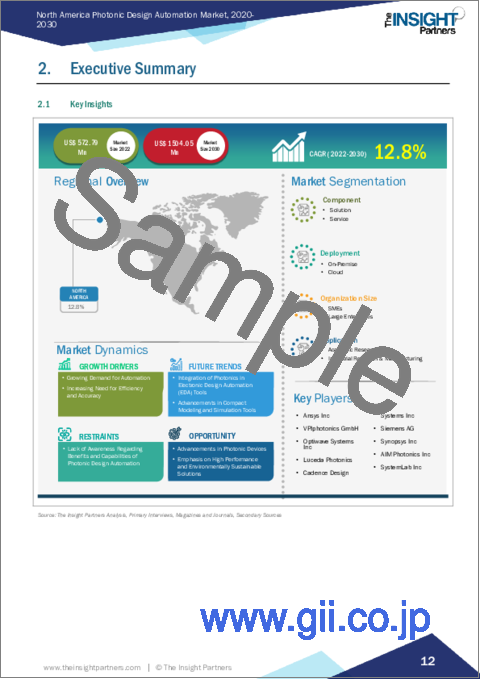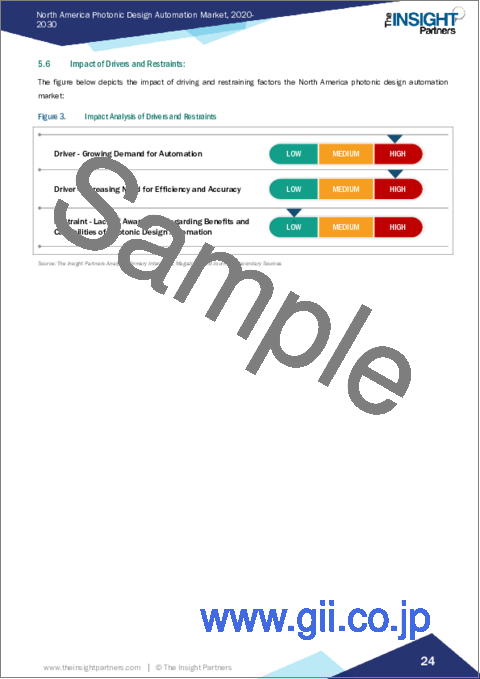|
|
市場調査レポート
商品コード
1562365
北米のフォトニックデザインオートメーション:2030年市場予測- 地域別分析- コンポーネント、展開、組織規模、用途別North America Photonic Design Automation Market Forecast to 2030 - Regional Analysis - by Component, Deployment, Organization Size, and Application |
||||||
|
|||||||
| 北米のフォトニックデザインオートメーション:2030年市場予測- 地域別分析- コンポーネント、展開、組織規模、用途別 |
|
出版日: 2024年07月04日
発行: The Insight Partners
ページ情報: 英文 85 Pages
納期: 即納可能
|
全表示
- 概要
- 図表
- 目次
北米のフォトニックデザインオートメーション市場は、2022年に5億7,279万米ドルと評価され、2030年には15億405万米ドルに達すると予測されており、2022~2030年のCAGRは12.8%と予測されています。
電子デザインオートメーション(EDA)ツールへのフォトニクスの統合が北米のフォトニックデザインオートメーション市場を促進
電子デザインオートメーション(EDA)ツールへのフォトニクスの統合は、北米のフォトニックデザインオートメーション市場の重要な動向です。既存のEDAベンダーは、新興フォトニクス市場の可能性を認識し、既存のツールにフォトニクスに特化した機能や性能を組み込んでいます。この統合により、デザイン者はフォトニクスコンポーネントをシームレスにデザインに取り入れることができ、デザインプロセスを効率化し、フォトニクスデバイスの性能と機能を最適化することができます。フォトニクスをEDAツールに統合することで、デザイン者は使い慣れたデザイン環境とワークフローを活用することができ、専用のフォトニクスデザインツールに伴う学習曲線が短縮されます。また、フォトニクスをEDAツールに統合することで、エレクトロニクスとフォトニクスの融合が促進され、エレクトロニクスとフォトニクスの融合回路の開発が可能になります。この融合は、シリコンフォトニクスなどの技術の進歩にとって極めて重要であり、フォトニクスとICデザインの間でツール、プロセス、シミュレーションモデルを共有することで、フォトニクスデザインオートメーションの開発が加速されます。全体として、EDAツールへのフォトニクスの統合は、フォトニクスの重要性の高まりと、フォトニクスセグメントにおける効率的なデザインプロセスと最適化技術の必要性に対する業界の認識を反映しています。これにより、デザイン者はフォトニクスのポテンシャルを活用し、電子デザインにシームレスに組み込むことができます。
北米のフォトニックデザインオートメーション市場概要
北米市場は米国とカナダに区分されます。北米は世界のフォトニックデザインオートメーション市場において主要な参入企業であり、主要技術企業、研究機関、強固な製造エコシステムが存在します。この地域は、様々な産業でフォトニックデザインオートメーション技術が大きく成長し、採用されています。高速・広帯域通信ネットワークのニーズの高まりは、北米のフォトニックデザインオートメーション市場の主要な促進要因です。同地域の学界と産業界の強力な協力関係は、最先端のアルゴリズム、シミュレーションツール、デザイン手法の進歩を刺激し、企業が技術進歩の最前線に立ち続けることを確実にしています。フォトニクスデザインオートメーションツールは、これらのデバイスのデザインと最適化に重要な役割を果たし、その性能と信頼性を保証します。
さらに、北米にはフォトニクスとその関連セグメントを専門とする有名大学や研究機関があり、研究開発が盛んです。これらの研究機関は、業界関係者と積極的に協力して最先端技術を開発し、フォトニクスデザインオートメーション市場のイノベーションを推進しています。先進的なアルゴリズム、シミュレーションツール、デザイン手法の開発は、この地域の強固な産学連携によって促進されており、企業は技術進歩の最先端に立ち続けることができます。市場参入企業の観点から見ると、北米にはフォトニックデザインオートメーションソリューションを提供する大手企業が数社あります。これらの企業は、ソフトウェア開発、半導体デザイン、フォトニクスの専門知識を活用し、包括的なデザインオートメーションツールとサービスを提供しています。北米市場はダイナミックで革新的なビジネス環境を示しており、業界をリードする老舗企業と新興新興企業が混在しています。さらに、この地域はモノのインターネット(IoT)、機械学習(ML)、人工知能(AI)などの最先端技術の研究開発に重点を置いており、競争優位性に貢献しています。これらの先端技術をフォトニックデザインオートメーションと統合することで、デザイン能力の強化、最適化、デザインプロセスのオートメーションが可能になります。
北米のフォトニックデザインオートメーション市場の収益と2030年までの予測(金額)
北米のフォトニックデザインオートメーション市場セグメンテーション
北米のフォトニックデザインオートメーション市場は、コンポーネント、展開、組織規模、用途、国によって区分されます。
コンポーネントに基づいて、北米のフォトニックデザインオートメーション市場はソリューションとサービスに二分されます。2022年にはソリューションセグメントが大きなシェアを占めています。
展開では、北米のフォトニックデザインオートメーション市場はオンプレミスとクラウドに二分されます。2022年にはオンプレミスセグメントが大きなシェアを占めています。
組織規模別では、北米のフォトニックデザインオートメーション市場は中小企業と大企業に二分されます。大企業セグメントが2022年に大きなシェアを占めています。
用途別では、北米のフォトニックデザインオートメーション市場フォトニックデザインオートメーション市場は、学術研究と産業研究&製造に二分されます。産業研究&製造セグメントが2022年に大きなシェアを占めています。
国別では、北米のフォトニックデザインオートメーション市場は米国とカナダに分類されます。米国は、2022年に北米のフォトニックデザインオートメーション市場を独占しました。
Ansys Inc、VPIphotonics GmbH、Optiwave Systems Inc、Luceda Photonics、Cadence Design Systems Inc、Siemens AG、Synopsys Inc、AIM Photonics Inc、SystemLab Incは、北米のフォトニックデザインオートメーション市場で事業を展開している主要企業です。
目次
第1章 イントロダクション
第2章 エグゼクティブサマリー
- 主要洞察
- 市場の魅力
第3章 調査手法
- 調査範囲
- 2次調査
- 1次調査
第4章 北米のフォトニックデザインオートメーション市場情勢
- イントロダクション
- エコシステム分析
- バリューチェーンのベンダー一覧
第5章 北米のフォトニックデザインオートメーション市場:主要市場力学
- 北米のフォトニックデザインオートメーション市場:主要市場力学
- 市場促進要因
- オートメーション需要の高まり
- 効率性と精度に対するニーズの高まり
- 市場抑制要因
- フォトニックデザインオートメーションの利点と能力に関する認識不足
- 市場機会
- フォトニックデバイスの進歩
- 高性能かつ環境的にサステイナブルソリューションの重視
- 今後の動向
- 電子デザインオートメーション(EDA)ツールへのフォトニクスの統合
- コンパクトなモデリングとシミュレーションツールの進歩
- 促進要因と阻害要因の影響
第6章 フォトニクスデザインオートメーション市場:北米市場分析
- 北米のフォトニックデザインオートメーション市場収益、2022~2030年
- 北米のフォトニックデザインオートメーション市場の予測と分析
第7章 北米のフォトニックデザインオートメーション市場分析-コンポーネント
- ソリューション
- ソリューション市場、収益と2030年までの予測
- サービス
- サービス概要
- サービス市場、収益と2030年までの予測
第8章 北米のフォトニックデザインオートメーション市場分析-展開
- オンプレミス
- オンプレミス
- オンプレミス市場、収益と2030年までの予測
- クラウド
- クラウド概要
- クラウド市場、収益と2030年までの予測
第9章 北米のフォトニックデザインオートメーション市場分析-組織規模
- 中小企業
- 中小企業市場、収益と2030年までの予測
- 大企業
- 大企業概要
- 大企業市場、収益と2030年までの予測
第10章 北米のフォトニックデザインオートメーション市場分析-用途
- 学術研究
- 学術研究市場、収益と2030年までの予測
- 産業研究・製造
- 産業研究・製造市場、収益と2030年までの予測
第11章 北米のフォトニックデザインオートメーション市場:国別分析
- 北米
- 米国
- カナダ
第12章 業界情勢
- イントロダクション
- 市場イニシアティブ
- 新製品開発
- 合併と買収
第13章 企業プロファイル
- Ansys Inc
- VPlphotonics GmbH
- Optiwave Systems Inc
- Luceda Photonics
- Cadence Design Systems Inc
- Siemens AG
- Synopsys Inc
- AIM Photonics Inc
- SystemLab Inc
第14章 付録
List Of Tables
- Table 1. North America Photonic Design Automation Market Segmentation
- Table 2. North America Photonic Design Automation Market Revenue and Forecasts to 2030 (US$ Million)
- Table 3. North America Photonic Design Automation Market Revenue and Forecasts to 2030 (US$ Million) - Component
- Table 4. North America Photonic Design Automation Market Revenue and Forecasts to 2030 (US$ Million) - Deployment
- Table 5. North America Photonic Design Automation Market Revenue and Forecasts to 2030 (US$ Million) - Organization Size
- Table 6. North America Photonic Design Automation Market Revenue and Forecasts to 2030 (US$ Million) - Application
- Table 7. North America Photonic Design Automation Market Revenue and Forecasts to 2030 (US$ Mn) - By Country
- Table 8. US Photonic Design Automation Market Revenue and Forecasts to 2030 (US$ Mn) - By Component
- Table 9. US Photonic Design Automation Market Revenue and Forecasts to 2030 (US$ Mn) - By Deployment
- Table 10. US Photonic Design Automation Market Revenue and Forecasts to 2030 (US$ Mn) - By Organization Size
- Table 11. US Photonic Design Automation Market Revenue and Forecasts to 2030 (US$ Mn) - By Application
- Table 12. Canada Photonic Design Automation Market Revenue and Forecasts to 2030 (US$ Mn) - By Component
- Table 13. Canada Photonic Design Automation Market Revenue and Forecasts to 2030 (US$ Mn) - By Deployment
- Table 14. Canada Photonic Design Automation Market Revenue and Forecasts to 2030 (US$ Mn) - By Organization Size
- Table 15. Canada Photonic Design Automation Market Revenue and Forecasts to 2030 (US$ Mn) - By Application
- Table 16. List of Abbreviation
List Of Figures
- Figure 1. North America Photonic Design Automation Market Segmentation, By Country
- Figure 2. Ecosystem: North America Photonic Design Automation Market
- Figure 3. Impact Analysis of Drivers and Restraints
- Figure 4. North America Photonic Design Automation Market Revenue (US$ Million), 2022 - 2030
- Figure 5. North America Photonic Design Automation Market Share (%) - Component, 2022 and 2030
- Figure 6. Solution Market Revenue and Forecasts to 2030 (US$ Million)
- Figure 7. Service Market Revenue and Forecasts to 2030 (US$ Million)
- Figure 8. North America Photonic Design Automation Market Share (%) - Deployment, 2022 and 2030
- Figure 9. On-Premise Market Revenue and Forecasts to 2030 (US$ Million)
- Figure 10. Cloud Market Revenue and Forecasts to 2030 (US$ Million)
- Figure 11. North America Photonic Design Automation Market Share (%) - Organization Size, 2022 and 2030
- Figure 12. SMEs Market Revenue and Forecasts to 2030 (US$ Million)
- Figure 13. Large Enterprises Market Revenue and Forecasts to 2030 (US$ Million)
- Figure 14. North America Photonic Design Automation Market Share (%) - Application, 2022 and 2030
- Figure 15. Academic Research Market Revenue and Forecasts to 2030 (US$ Million)
- Figure 16. Industrial Research & Manufacturing Market Revenue and Forecasts to 2030 (US$ Million)
- Figure 17. North America Photonic Design Automation Market- Revenue by Key Countries 2022 (US$ Million)
- Figure 18. North America Photonic Design Automation Market Breakdown by Key Countries, 2022 and 2030 (%)
- Figure 19. US Photonic Design Automation Market Revenue and Forecasts to 2030 (US$ Mn)
- Figure 20. Canada Photonic Design Automation Market Revenue and Forecasts to 2030 (US$ Mn)
The North America photonic design automation market was valued at US$ 572.79 million in 2022 and is expected to reach US$ 1,504.05 million by 2030; it is estimated to register at a CAGR of 12.8% from 2022 to 2030.
Integration of Photonics in Electronic Design Automation (EDA) Tools Fuels North America Photonic Design Automation Market
The integration of photonics into electronic design automation (EDA) tools is a significant trend in the North America photonic design automation market. Established EDA vendors recognize the potential of the emerging photonics market and incorporate photonics-specific features and capabilities into their existing tools. This integration enables designers to seamlessly incorporate photonics components into their designs, streamlining the design process and optimizing the performance and functionality of photonic devices. By integrating photonics into EDA tools, designers can leverage familiar design environments and workflows, reducing the learning curve associated with specialized photonic design tools. The integration of photonics into EDA tools also facilitates the convergence of electronics and photonics, enabling the development of integrated electronic-photonic circuits. This convergence is crucial for the advancement of technologies such as silicon photonics, where the sharing of tools, processes, and simulation models between photonics and IC design accelerates the development of photonic design automation. Overall, the integration of photonics into EDA tools reflects the industry's recognition of the growing importance of photonics and the need for efficient design processes and optimization techniques in the photonic field. It enables designers to harness the potential of photonics and seamlessly incorporate it into their electronic designs.
North America Photonic Design Automation Market Overview
The market in North America is segmented into the US and Canada. North America is a key player in the global photonic design automation market, with a strong presence of leading technology companies, research institutions, and a robust manufacturing ecosystem. This region has witnessed significant growth and adoption of photonic design automation technologies across various industries. The rising need for high-speed and high-bandwidth communication networks is a key driver for the photonic design automation market in North America. The strong collaboration between academia and industry in the region stimulates the advancement of cutting-edge algorithms, simulation tools, and design methodologies, ensuring that companies remain at the forefront of technological progress. Photonic design automation tools play a crucial role in designing and optimizing these devices, ensuring their performance and reliability.
Moreover, North America has a thriving research and development landscape, with renowned universities and research institutions dedicated to photonics and related fields. These institutions actively collaborate with industry players to develop cutting-edge technologies and drive innovation in the photonic design automation market. The development of advanced algorithms, simulation tools, and design methodologies is facilitated by robust academic-industry partnerships in the region, allowing companies to remain at the cutting edge of technological advancements. In terms of market players, North America is home to several major companies that offer photonic design automation solutions. These companies leverage their expertise in software development, semiconductor design, and photonics to provide comprehensive design automation tools and services. The North America market exhibits a dynamic and innovative business environment, comprising a blend of established industry leaders and emerging startups. Furthermore, the region's emphasis on research and development in leading-edge technologies such as the Internet of Things (IoT), machine learning (ML), and artificial intelligence (AI) contributes to its competitive advantage. The integration of these advanced technologies with photonic design automation empowers the industry with enhanced design capabilities, optimization, and automation of the design process.
North America Photonic Design Automation Market Revenue and Forecast to 2030 (US$ Million)
North America Photonic Design Automation Market Segmentation
The North America photonic design automation market is segmented based on component, deployment, organization size, application, and country.
Based on component, the North America photonic design automation market photonic design automation market is bifurcated into solution and service. The solution segment held a larger share in 2022.
In terms of deployment, the North America photonic design automation market photonic design automation market is bifurcated into on-premise and cloud. The on-premise segment held a larger share in 2022.
By organization size, the North America photonic design automation market photonic design automation market is bifurcated into SMEs and large enterprises. The large enterprises segment held a larger share in 2022.
In terms of application, the North America photonic design automation market photonic design automation market is bifurcated into academic research and industrial research & manufacturing. The industrial research & manufacturing segment held a larger share in 2022.
Based on country, the North America photonic design automation market is categorized into the US and Canada. The US dominated the North America photonic design automation market in 2022.
Ansys Inc, VPIphotonics GmbH, Optiwave Systems Inc, Luceda Photonics, Cadence Design Systems Inc, Siemens AG, Synopsys Inc, AIM Photonics Inc, and SystemLab Inc are some of the leading companies operating in the North America photonic design automation market.
Table Of Contents
1. Introduction
- 1.1 The Insight Partners Research Report Guidance
- 1.2 Market Segmentation
2. Executive Summary
- 2.1 Key Insights
- 2.2 Market Attractiveness
3. Research Methodology
- 3.1 Coverage
- 3.2 Secondary Research
- 3.3 Primary Research
4. North America Photonic Design Automation Market Landscape
- 4.1 Overview
- 4.2 Ecosystem Analysis
- 4.2.1 List of Vendors in the Value Chain:
5. North America Photonic Design Automation Market - Key Market Dynamics
- 5.1 North America Photonic Design Automation Market - Key Market Dynamics
- 5.2 Market Drivers
- 5.2.1 Growing Demand for Automation
- 5.2.2 Increasing Need for Efficiency and Accuracy
- 5.3 Market Restraints
- 5.3.1 Lack of Awareness Regarding Benefits and Capabilities of Photonic Design Automation
- 5.4 Market Opportunities
- 5.4.1 Advancements in Photonic Devices
- 5.4.2 Emphasis on High Performance and Environmentally Sustainable Solutions
- 5.5 Future Trends
- 5.5.1 Integration of Photonics in Electronic Design Automation (EDA) Tools
- 5.5.2 Advancements in Compact Modelling and Simulation Tools
- 5.6 Impact of Drivers and Restraints:
6. Photonic Design Automation Market - North America Market Analysis
- 6.1 North America Photonic Design Automation Market Revenue (US$ Million), 2022 - 2030
- 6.2 North America Photonic Design Automation Market Forecast and Analysis
7. North America Photonic Design Automation Market Analysis - Component
- 7.1 Solution
- 7.1.1 Overview
- 7.1.2 Solution Market, Revenue and Forecast to 2030 (US$ Million)
- 7.2 Service
- 7.2.1 Overview
- 7.2.2 Service Market, Revenue and Forecast to 2030 (US$ Million)
8. North America Photonic Design Automation Market Analysis - Deployment
- 8.1 On-Premise
- 8.1.1 Overview
- 8.1.2 On-Premise Market, Revenue and Forecast to 2030 (US$ Million)
- 8.2 Cloud
- 8.2.1 Overview
- 8.2.2 Cloud Market, Revenue and Forecast to 2030 (US$ Million)
9. North America Photonic Design Automation Market Analysis - Organization Size
- 9.1 SMEs
- 9.1.1 Overview
- 9.1.2 SMEs Market, Revenue and Forecast to 2030 (US$ Million)
- 9.2 Large Enterprises
- 9.2.1 Overview
- 9.2.2 Large Enterprises Market, Revenue and Forecast to 2030 (US$ Million)
10. North America Photonic Design Automation Market Analysis - Application
- 10.1 Academic Research
- 10.1.1 Overview
- 10.1.2 Academic Research Market, Revenue and Forecast to 2030 (US$ Million)
- 10.2 Industrial Research & Manufacturing
- 10.2.1 Overview
- 10.2.2 Industrial Research & Manufacturing Market, Revenue and Forecast to 2030 (US$ Million)
11. North America Photonic Design Automation Market - Country Analysis
- 11.1 North America
- 11.1.1 North America Photonic Design Automation Market Overview
- 11.1.2 North America Photonic Design Automation Market Revenue and Forecasts and Analysis - By Country
- 11.1.2.1 North America Photonic Design Automation Market Revenue and Forecasts and Analysis - By Country
- 11.1.2.2 US Photonic Design Automation Market Revenue and Forecasts to 2030 (US$ Mn)
- 11.1.2.2.1 US Photonic Design Automation Market Breakdown, by Component
- 11.1.2.2.2 US Photonic Design Automation Market Breakdown, by Deployment
- 11.1.2.2.3 US Photonic Design Automation Market Breakdown, by Organization Size
- 11.1.2.2.4 US Photonic Design Automation Market Breakdown, by Application
- 11.1.2.3 Canada Photonic Design Automation Market Revenue and Forecasts to 2030 (US$ Mn)
- 11.1.2.3.1 Canada Photonic Design Automation Market Breakdown, by Component
- 11.1.2.3.2 Canada Photonic Design Automation Market Breakdown, by Deployment
- 11.1.2.3.3 Canada Photonic Design Automation Market Breakdown, by Organization Size
- 11.1.2.3.4 Canada Photonic Design Automation Market Breakdown, by Application
12. Industry Landscape
- 12.1 Overview
- 12.2 Market Initiative
- 12.2 New Product Development
- 12.3 Merger and Acquisition
13. Company Profiles
- 13.1 Ansys Inc
- 13.1.1 Key Facts
- 13.1.2 Business Description
- 13.1.3 Products and Services
- 13.1.4 Financial Overview
- 13.1.5 SWOT Analysis
- 13.1.6 Key Developments
- 13.2 VPlphotonics GmbH
- 13.2.1 Key Facts
- 13.2.2 Business Description
- 13.2.3 Products and Services
- 13.2.4 Financial Overview
- 13.2.5 SWOT Analysis
- 13.2.6 Key Developments
- 13.3 Optiwave Systems Inc
- 13.3.1 Key Facts
- 13.3.2 Business Description
- 13.3.3 Products and Services
- 13.3.4 Financial Overview
- 13.3.5 SWOT Analysis
- 13.3.6 Key Developments
- 13.4 Luceda Photonics
- 13.4.1 Key Facts
- 13.4.2 Business Description
- 13.4.3 Products and Services
- 13.4.4 Financial Overview
- 13.4.5 SWOT Analysis
- 13.4.6 Key Developments
- 13.5 Cadence Design Systems Inc
- 13.5.1 Key Facts
- 13.5.2 Business Description
- 13.5.3 Products and Services
- 13.5.4 Financial Overview
- 13.5.5 SWOT Analysis
- 13.5.6 Key Developments
- 13.6 Siemens AG
- 13.6.1 Key Facts
- 13.6.2 Business Description
- 13.6.3 Products and Services
- 13.6.4 Financial Overview
- 13.6.5 SWOT Analysis
- 13.6.6 Key Developments
- 13.7 Synopsys Inc
- 13.7.1 Key Facts
- 13.7.2 Business Description
- 13.7.3 Products and Services
- 13.7.4 Financial Overview
- 13.7.5 SWOT Analysis
- 13.7.6 Key Developments
- 13.8 AIM Photonics Inc
- 13.8.1 Key Facts
- 13.8.2 Business Description
- 13.8.3 Products and Services
- 13.8.4 Financial Overview
- 13.8.5 SWOT Analysis
- 13.8.6 Key Developments
- 13.9 SystemLab Inc
- 13.9.1 Key Facts
- 13.9.2 Business Description
- 13.9.3 Products and Services
- 13.9.4 Financial Overview
- 13.9.5 SWOT Analysis
- 13.9.6 Key Developments
14. Appendix
- 14.1 Word Index





